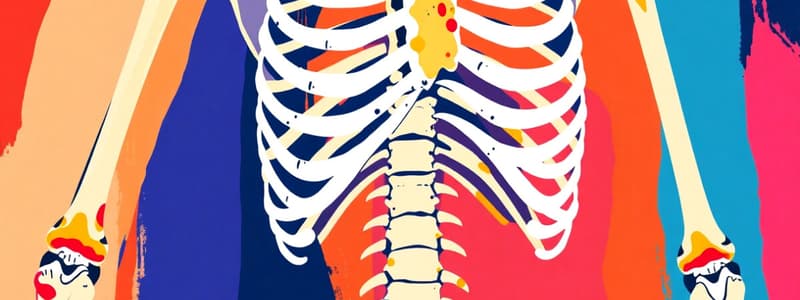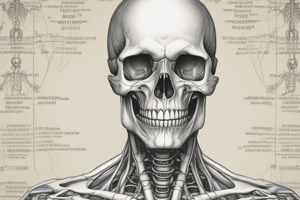Podcast
Questions and Answers
What type of bones are primarily found in the free extremities, excluding the wrist and ankle?
What type of bones are primarily found in the free extremities, excluding the wrist and ankle?
- Irregular bones
- Long bones (correct)
- Flat bones
- Short bones
What structure separates the diaphysis and epiphysis during growth?
What structure separates the diaphysis and epiphysis during growth?
- Articular cartilage
- Epiphyseal cartilage (correct)
- Synovial membrane
- Periosteum
Which type of joint is characterized by immobility?
Which type of joint is characterized by immobility?
- Syndesmosis
- Diarthrosis
- Synarthrosis (correct)
- Synovial joint
Which bones are NOT considered irregular bones?
Which bones are NOT considered irregular bones?
What is the primary function of the periosteum?
What is the primary function of the periosteum?
Which type of bone is characterized by being cube-shaped?
Which type of bone is characterized by being cube-shaped?
What can be a consequence of the presence of accessory bones in the hand and foot?
What can be a consequence of the presence of accessory bones in the hand and foot?
What distinguishes long bones from other types of bones in terms of growth structure?
What distinguishes long bones from other types of bones in terms of growth structure?
What is the primary material that makes up the menisci of the knee joint?
What is the primary material that makes up the menisci of the knee joint?
What is the average thickness of joint cartilage in most areas?
What is the average thickness of joint cartilage in most areas?
What is the function of interarticular disks in joints?
What is the function of interarticular disks in joints?
How does joint cartilage receive nutrients?
How does joint cartilage receive nutrients?
What condition is particularly linked to a lack of movement in joint cartilage?
What condition is particularly linked to a lack of movement in joint cartilage?
What is a key component of the extracellular matrix in joint cartilage?
What is a key component of the extracellular matrix in joint cartilage?
Why does joint cartilage have poor regenerative power?
Why does joint cartilage have poor regenerative power?
Which joint structure is a continuation of the periosteum?
Which joint structure is a continuation of the periosteum?
What type of joint allows rotational movement around one axis?
What type of joint allows rotational movement around one axis?
Which joint type has two main axes of movement and allows four main movements?
Which joint type has two main axes of movement and allows four main movements?
What primarily determines the direction of movement in a joint?
What primarily determines the direction of movement in a joint?
Which joint type features a cylindrical bone end fitted into a gutterlike depression?
Which joint type features a cylindrical bone end fitted into a gutterlike depression?
Which joints allow gliding movements?
Which joints allow gliding movements?
What term describes the type of limitations in joint movement based on the joint structure?
What term describes the type of limitations in joint movement based on the joint structure?
Which joint is an example of a Condyloid Joint?
Which joint is an example of a Condyloid Joint?
What type of joint is mostly limited to one axis of movement?
What type of joint is mostly limited to one axis of movement?
What is the primary function of the synovial membrane in joints?
What is the primary function of the synovial membrane in joints?
What happens to a joint when it is immobilized for a long period of time?
What happens to a joint when it is immobilized for a long period of time?
Which joint type allows for the least mobility?
Which joint type allows for the least mobility?
What is a characteristic feature of ball-and-socket joints?
What is a characteristic feature of ball-and-socket joints?
What role does synovial fluid play in joint function?
What role does synovial fluid play in joint function?
Which type of joint is typically associated with rotational movement?
Which type of joint is typically associated with rotational movement?
What could cause a joint capsule to shrink?
What could cause a joint capsule to shrink?
Which of the following joints is classified as a hinge joint?
Which of the following joints is classified as a hinge joint?
What is the primary function of the biceps brachii in the upper arm?
What is the primary function of the biceps brachii in the upper arm?
Which muscle serves as the extensor at the elbow joint?
Which muscle serves as the extensor at the elbow joint?
Where does the triceps brachii insert?
Where does the triceps brachii insert?
What term describes muscles that work together to perform a movement?
What term describes muscles that work together to perform a movement?
How are muscles classified that extend over two or more joints?
How are muscles classified that extend over two or more joints?
What is the formula representing the mechanics of muscle power in the context of leverage?
What is the formula representing the mechanics of muscle power in the context of leverage?
What type of muscle has several origins but a single belly and tendon?
What type of muscle has several origins but a single belly and tendon?
Which of the following muscle types has opposing actions?
Which of the following muscle types has opposing actions?
Study Notes
Skeletal Elements and Function
- Protect organ systems such as the skull, vertebral canal and chest cage
Bony Skeleton
- Consists of approximately 200 bones connected by cartilage, fibrous and synovial joints.
- Bones have a connective tissue sheath called periosteum, which acts like a stocking.
- Bone shape is determined by genetics and structural demand.
- Bones are categorized into: long, short, flat, and irregular bones.
- Long bones: found in limbs, with diaphysis and epiphysis at the ends.
- Short bones: found in the wrist and ankle.
- Flat Bones: Include ribs, breast bone, shoulder blade and bones of the skull.
- Irregular bones: vertebrae and bones at the base of the skull.
- Some skull bones contain air-filled cavities.
- Sesamoid bones are located within tendons for example, the kneecap.
Joints
- These are connections between bones or cartilage, allowing for movement and force transmission.
- Categorized as immovable (synarthroses) or movable (diarthroses).
Immovable Joints (Synarthroses)
- Skeleton parts are separated by tissues like cartilage or connective tissue.
- Include interarticular disks, articular lips and intraarticular ligaments.
- Menisci, made of fibrocartilage, are found in the knee.
Movable Joints
- Have a joint space with synovial fluid.
- Joint cartilage is mostly hyaline cartilage, providing shock absorption and mechanical support.
- Joint cartilage lacks blood vessels, requiring nutrients from synovial fluid.
- Optimal cartilage nutrition requires regular movement, loading, and unloading.
- Lack of movement can lead to osteoarthritis, particularly in older people.
- Joint capsule is a continuation of the periosteum with an outer fibrous layer and an inner synovial membrane.
- Synovial fluid lubricates and nourishes the joint cartilage.
Slightly Movable Joints (Amphiarthroses)
- Have limited mobility due to the shape of their facets and strong ligaments.
- Examples include the tibiofibular joint and the sacroiliac joint.
Types of Joints
- Joints can be classified based on their mobility axes, degrees of freedom, or components.
- Classification by shape and configuration of joint surfaces:
- Ball-and-socket joints: allow movement in three axes (hip and shoulder joints).
- Condyloid joints: allow movement in two axes (wrist and occipital condyles).
- Hinge joints: allow movement in one axis (elbow joint).
- Pivot joints: allow rotation around one axis (radioulnar joint).
- Saddle joints: allow movement in two axes (wrist joint).
- Plane joints: allow gliding movements (small joints of vertebrae).
Joint Mechanics
- The arrangement of muscles and ligaments determines the direction of movement.
- Muscles provide forces to ensure joint integrity and movement.
- Limitations to movement are caused by bone, muscle, ligaments, and soft tissue.
- Movements occur around axes, often related to specific joint actions.
Muscles
- Muscles are responsible for movement, and consist of bundles of muscle fibers wrapped in connective tissue.
- They are anchored to bones by tendons, which transmit forces for movement.
- Most muscles have an origin and an insertion point.
- Muscles may be two, three, or four-headed with multiple origins.
- Digastric muscles have a single head but one intersecting tendon.
- Muscles can be classified according to:
- The way they are inserted into tendons.
- Whether they act on one or multiple joints (diarthric or polyarthric).
- How they work together or oppose each other (synergists or antagonists).
Studying That Suits You
Use AI to generate personalized quizzes and flashcards to suit your learning preferences.
Related Documents
Description
Test your knowledge on the skeletal system, including the structure and function of bones and joints. This quiz covers the types of bones, their classifications, and the protective roles they play in the body. Delve into the details of the skeletal framework and enhance your understanding of human anatomy.




